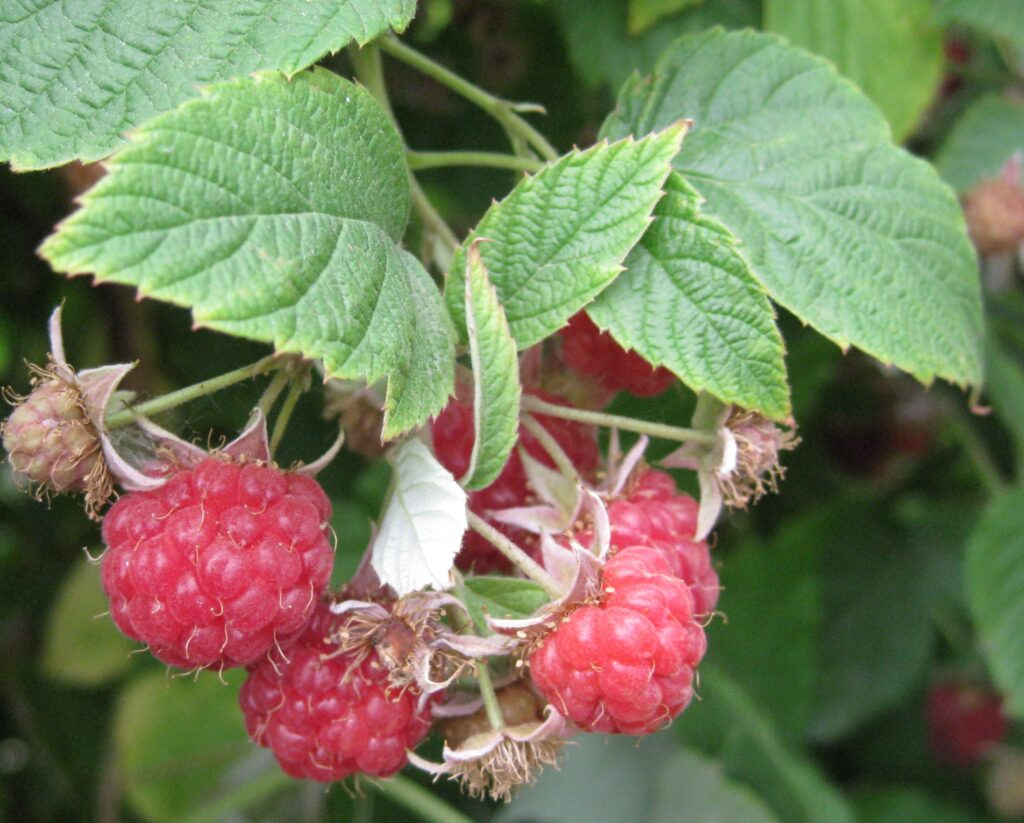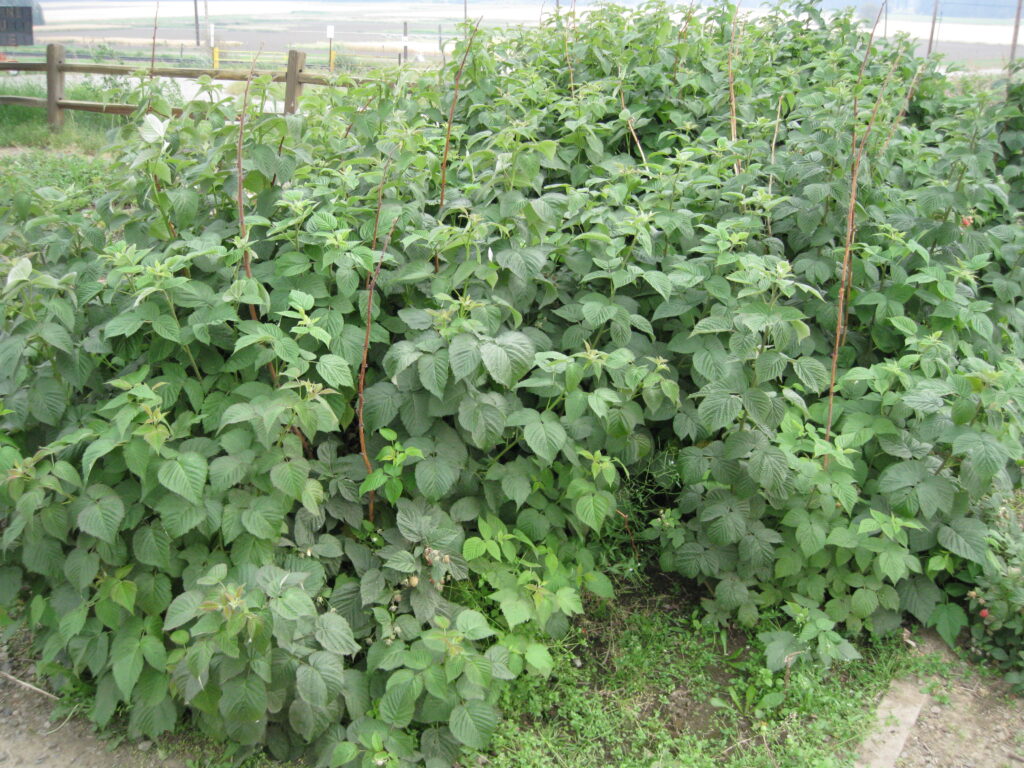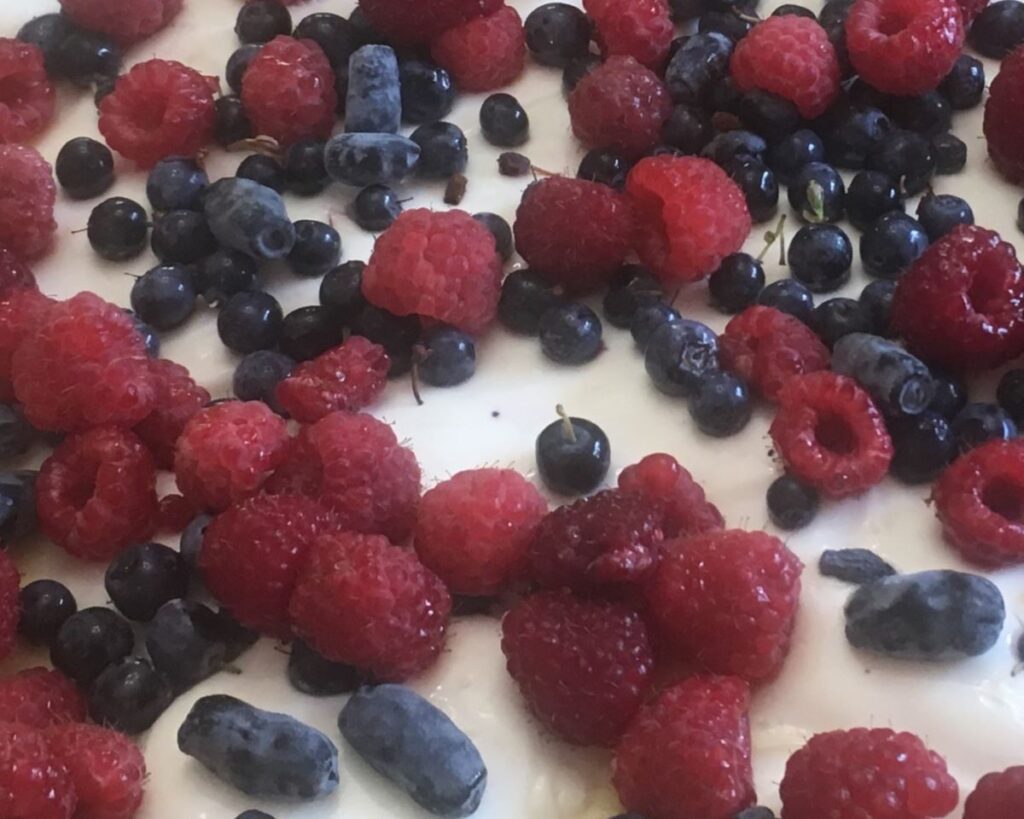Most gardeners I know tend to be fairly haphazard with their raspberry patches and that may include myself. And you can be because they tend to spread on their own (much more than you might want in some cases) and come back year after year without too much effort. However, with some forethought to the soil, attention to variety you’re planting, and regular pruning, you can maximize the quality and production of your raspberry patch.

Raspberries are personally one of my favorite berries to eat fresh or frozen. Although American red raspberries (Rubus idaeus L.) grow wild throughout Alaska, they can be annoyingly small and wormy, although their intense taste does compensate somewhat for these drawbacks. But in my backyard, I’d rather grow larger, more productive cultivars of raspberries. Raspberries also meet most of the criteria I have when choosing what to grow: they are a high dollar item, best fresh, highly perishable, can be eaten without cooking, can be harvested successively, and are something my family will eat as much of as I can grow. As with strawberries, there is a lot to learn about how to maximize production.

Choosing which Raspberry Cultivars to Grow
There are several important factors to consider when starting a raspberry patch and choosing which variety to grow, depending on what region of Alaska you live in, and the growing conditions there.
The roots and crowns of raspberry plants are perennial and generally have a lifespan of 10-15 years, however, the canes are biennials. In the first year, the cane is called a primocane and in the second year it is called a floricane. Raspberries can be divided into two main categories—summer bearing (floricane-fruiting) or fall bearing (primocane-fruiting or everbearing). It’s important to know which type of raspberry you’re growing to know how to prune it as well as to ensure that you have a variety that will bear fruit before the first frost of the fall and early enough to harvest. Nursery descriptions of varieties can be helpful, but they are not specific to Alaska growing conditions and what is meant by summer or fall can be very different than what is meant by summer and fall in Alaska. Oregon State University’s publication on Raspberry Cultivars for the Pacific Northwest is a comprehensive and unbiased description of widely available raspberry cultivars. I especially like that they’re listed in order of fruiting. Summer bearers are most commonly grown in Alaska because many fall bearer cultivars will not bear fruit before the first frosts and winter has set in. Season extension or greenhouse techniques could push the season, but I’m not sure it would be worth the trouble, given there are many cultivars that will bear fruit in time.
In the Arctic and Interior regions of Alaska, cold hardiness is perhaps one of the primary considerations when choosing a variety. The cold hardiness of the crown and the overwintering canes both need to be considered. Many raspberry cultivars are rated as hardy in Zones 3 to 8. According to the Alaska Garden Helper Hardiness Zones, Fairbanks, Alaska may be transitioning from a Zone 2b (1980-2009) to Zone 4a (2010-2039). This may expand which varieties we can grow. For summer bearers, the crown and floricane need to withstand winter temperatures. For fall bearers, just the crown needs to be winter hardy, if they are pruned to the ground each year.

For coastal Alaska, root rot resistance may be a primary consideration, and resistance to other diseases is always a good characteristic to consider.
Size and Taste: I’ve eaten some truly tasteless raspberries. If you can, sample different varieties at a local U-pick farm or botanical garden. You may need to ask what variety is being grown and you will need to ask permission to sample at most botanical gardens. You also may want to purchase a few varieties before establishing your patch and see which ones you like best and which ones grow well. If you are experimenting with more than one variety, you would need to separate the patches to keep track of what is growing where. You might be able to grow them in a container for a couple of years if you are experimenting, but you would probably need to bury the container in the winter to protect the berries from the cold.
Availability is yet another consideration. Some varieties that have been recommended in the past may no longer be widely available. Kiska is an example of a variety that was developed at the University of Alaska Fairbanks in the ’70s but is no longer widely available. Some cultivars are patented which could limit their availability to home gardeners, increase their price, and disallow you from propagating them. Local greenhouses may have a very limited selection. There are several options to order raspberry plants online.
These companies have raspberries and will ship to Alaska:
Some varieties are patented and so can be more expensive than heirloom varieties.
Boyne and Latham are tried and true varieties that have been the standby’s for Alaska for a longtime. They have been recommended by agricultural researchers, Extension, and farmers for years and are available at local greenhouses throughout Alaska. Fallgold is a fall bearer but also seems to be commonly grown and available from greenhouses throughout Alaska.
Canby is recommended by Extension for Southcentral in Alaska’s Sustainable Gardening Handbook and by Southcentral Alaska grower, Dwight Bradley, a member of the Alaska Pioneer Fruit Grower’s Association.
Red Mammoth is recommended for Interior Alaska by Extension. It’s not widely available but I did see it available from Food Forest Nursery.
Experimental Varieties: I want to try growing Prelude, Nova, and Encore in Fairbanks. Nova is rated down to Zone 3. The other two are rated to Zone 4-8 so I think with our warmer winters, these cultivars stand a good chance. Prelude is the earliest summer bearer on this list and who doesn’t want raspberries as soon as possible in the summer? However, these varieties will be a bit experimental as I don’t know of any recommendations or trials for these cultivars in Interior Alaska.
Growing Raspberries
Oregon State University (OSU) Extension’s, Growing Raspberries in Your Home Garden in depth instructions for growing raspberries successfully including the ideal soil and nutrient requirements, proper spacing, pruning techniques, and trellising systems. Here I provide the basic growing recommendations from OSU’s publication. They recommend planting raspberries in well-drained soil, with a good layer of organic matter and mulch and a soil pH of 5.6 to 6.5. They recommend fertilizing based on a soil test, and when establishing a new patch, they recommend 2-3 oz. of Nitrogen per 10 feet of row per year. When the plants are dormant (late fall or early spring), summer bearer floricanes should be pruned. Raspberries should be planted 2 to 2.5 feet apart in rows that are 8 to 10 feet apart with a row width of about 6 to 12 inches wide maintained for summer bearers. This width will help you take care of your raspberry patch and limit the spread of disease. Some type of trellis should be used for support—t-posts and 12 gauge wire works well. I have seen fencing used before which makes it really difficult to pick the berries.
Eating and Cooking with Raspberries
Most of the raspberries we grow we eat fresh and right away. Any extra, I would freeze and eat with granola and blueberries and yogurt. And if I were lucky enough to have even more than that, I would make raspberry scones, my favorite scone of all time being Fire Island’s raspberry scone. This scone recipe, which calls for dried currants, is excellent with raspberries as a substitute as well. Finally, if I had even more, I would (and do) make Raspberry & pomegranate roulade from Yasmin Khan’s cookbook Ripe Figs: Recipes and Stories from the Eastern Mediterranean. If I were fortunate enough to have cloudberries, I would add them as well. And if I was blessed with even more raspberries, I would consider making jam or preserving them using UAF Cooperative Extension Services tested recipes or making yet more yummy things to eat.

Add your comments below: What varieties of raspberries have you successfully grown in Alaska? Please include your USDA Growing Zone, location, and raspberry variety you are growing, and how long you have been growing them for.